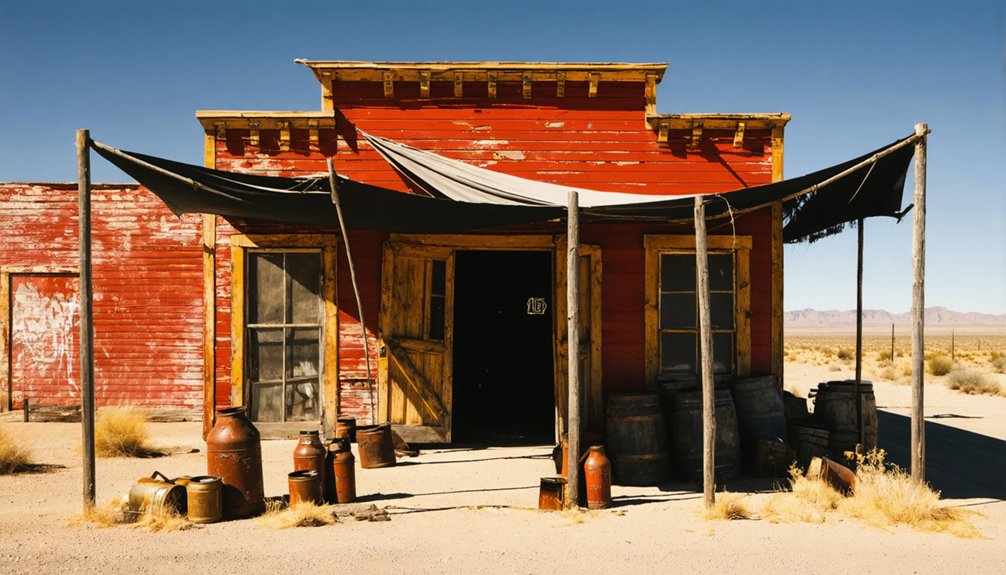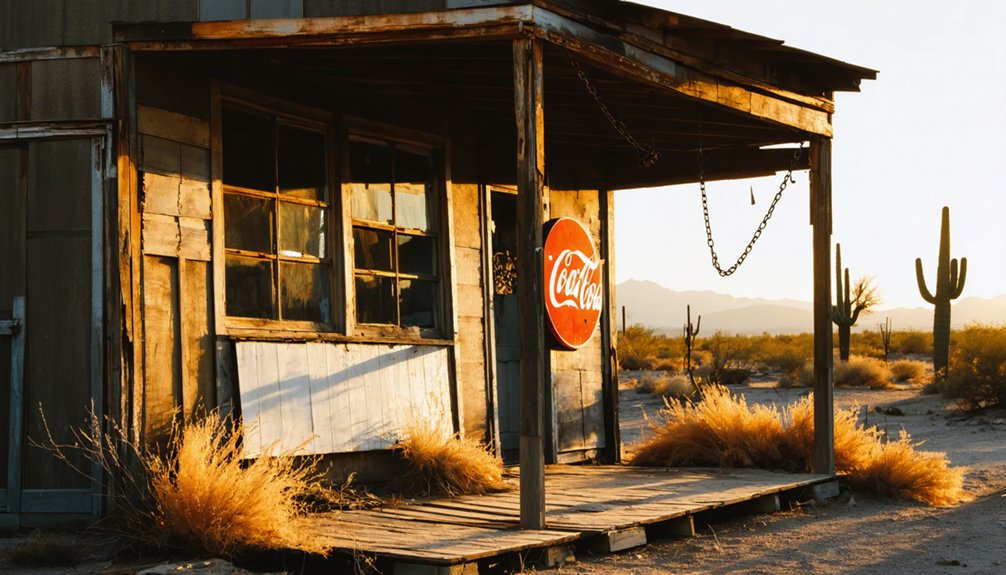Courtland, Arizona is a true copper ghost town that flourished briefly from 1909-1921. Founded by the Young brothers’ Great Western Copper Company, it quickly grew to 2,000 residents with productive mines like the Germania shaft extracting 6,000 tons of ore daily. Today, you’ll find only silent ruins, with the historic jail standing as the last complete structure. Unlike tourist-filled Tombstone, Courtland offers an authentic glimpse into Arizona’s raw mining past.
Key Takeaways
- Courtland became a copper mining boomtown in 1908 before declining as ore deposits proved too shallow for sustained operations.
- The Courtland Jail remains the only complete structure in this authentic ghost town, representing early 20th-century frontier architecture.
- At its peak (1911-1912), Courtland housed approximately 2,000 residents with a bustling main street and significant mining infrastructure.
- The ghost town’s ruins include foundation remnants of the electrical plant, Big Rock Store, and original street layouts.
- Photography opportunities are best at sunrise, with the jail and industrial structures offering dramatic compositions against the Arizona landscape.
The Rise and Fall of a Desert Copper Boomtown
While prospectors had staked claims in the Courtland area as early as the 1890s, the settlement initially known as Leadville or North Turquoise remained relatively quiet until 1908.
That year, rich copper veins were discovered, transforming the quiet outpost into a thriving boomtown almost overnight.
You’d have witnessed a remarkable change as the Great Western Copper Company, founded by the Young brothers from Iowa, dedicated land for a proper town named after Courtland Young.
What began as scattered tents quickly evolved into a planned community with streets, businesses, and essential infrastructure.
The Germania mine became the heart of copper mining operations, producing about 6,000 tons of ore daily at its peak.
Two railroads, the Mexico & Colorado and Arizona & Colorado, served the town by transporting copper ore and bringing in necessary supplies.
The town reached its zenith with a population of approximately 2,000 residents before beginning its decline as ore bodies proved relatively shallow.
A Day in the Life of Early Courtland Residents
As Courtland transformed from a dusty outpost into a bustling copper town, its residents established distinct daily rhythms shaped by the demands of desert mining life.
You’d wake before dawn, miners heading to the Great Western or Calumet & Arizona shafts for grueling shifts, while others maintained the water supply or ran the coal-fired power plant.
Your social standing determined your daily routines. If you were Mexican or Indigenous, you’d likely face exclusion from theaters and certain establishments despite forming the backbone of the mining workforce.
Copper wealth flowed from Indigenous and Mexican hands, yet doors remained closed to those who built Courtland from the earth itself.
After work, you’d gather at the segregated “tenderloin” district’s saloons or attend community gatherings at the baseball field. Weekly newspapers kept you informed, while the Wells Fargo office handled your finances.
Despite harsh conditions, Courtland’s 2,000 residents built a vibrant community amid the Arizona desert. The town’s peak prosperity around 1911-1912 coincided with Arizona’s achievement of statehood. Residents could purchase various necessities from the Big Rock Store, which served as the town’s central mercantile establishment.
What Remains: Exploring Courtland’s Ruins Today
The silent remnants of Courtland’s once-bustling streets offer you only whispers of its copper-fueled heyday.
The sturdy Courtland Jail stands as the last complete structure, a defiant sentinel against time and abandonment.
Your ruins exploration reveals surprising details—main street sidewalks still trace the town’s layout while foundations of the electrical plant with its oil-burning boilers mark human ingenuity in the desert.
You can still find remnants of the Big Rock Store, which was once the largest mercantile business in Courtland.
Throughout the valley, railroad tracks of the El Paso & Southwestern spur cut through the landscape.
Access restrictions protect Courtland’s archaeological significance, with guided tours available by appointment only.
You’ll need permission to visit, as the area bristles with dangerous open mine shafts and unstable ground.
Video cameras and patrols safeguard these fragile remnants from would-be trespassers.
A curious collection of forgotten artifacts forms what locals call a packrat table, including items as unusual as a mannequin head among the town’s ruins.
The Young Brothers and Courtland’s Mining Legacy
If you’re tracing Courtland’s origins, you’ll find the Young brothers at its foundation, with Iowa lumber magnates William and Courtland Young entering Arizona’s mining scene in 1899.
They transformed their mining claims near the Leadville/North Turquoise area into the Great Western Copper Company in 1900, issuing over a million dollars in stock despite slow initial progress.
The town itself was named after Courtland Young, who became a significant landowner connecting the company’s copper ventures to the settlement’s development and eventual boom that attracted over 2,000 residents at its peak. This historical location is now featured on disambiguation pages that help direct Wikipedia users to the correct Courtland article.
Copper and Capital
Capitalizing on Arizona’s rich mineral deposits, William and Courtland Young transformed a remote section of the southwestern desert into a bustling copper town at the turn of the 20th century.
After purchasing mining claims in 1899, they formed the Great Western Copper Company in 1900, establishing the framework for Courtland’s copper mining empire.
When exploring Courtland’s economic impact, you’ll discover:
- A million-dollar investment before 1908 that sparked Arizona’s territorial mining ambitions
- Complex underground networks where men risked their lives daily for copper riches
- The Germania mine’s impressive 6,000-ton daily ore production during peak operations
- A boom that created 2,000 jobs before the crushing limestone barrier at 300 feet ended dreams of unlimited wealth
The Youngs’ vision created prosperity where only desert existed before—until nature imposed its limits.
Iowa to Arizona
Before investing in Arizona’s copper claims, William and Courtland Young had established themselves as successful lumber magnates in Clinton, Iowa. Their pivotal Iowa migration to Arizona mining country began in 1899 when they purchased claims near what would become their namesake town.
In 1900, the brothers formed the Great Western Copper Company, channeling their business acumen and capital into developing these promising mineral deposits. They honored Courtland Young by naming the emerging settlement after him.
Their copper investment transformed the barren landscape into a thriving mining district that would soon support over 2,000 residents.
The Youngs’ vision and capital infusion built the infrastructure needed for successful mining operations, creating a quintessential western boom town where there had once been only desert and scattered prospector camps.
Photographing a Ghost Town: Best Views and Angles

You’ll capture Courtland’s most striking images at the old city jail, where early morning light accentuates its weathered architectural lines and creates dramatic shadows across its facade.
The jail remains the most intact structure in this Cochise County ghost town, offering photographers a perfect subject against Arizona’s clear blue skies.
For ideal results, position yourself along the eastern approach before 8:00 AM when golden rays highlight the texture of the century-old stonework while minimizing the harsh desert glare that washes out midday shots. The area also features interesting copper precipitation structures that provide unique industrial elements for your composition. Consider joining other ghost tours in Arizona that showcase similar historic abandoned towns if you enjoy photographing these atmospheric locations.
Morning Light Magic
As the first light of dawn breaks over the Dragoon Mountains, Courtland’s weathered ruins transform into a photographer’s paradise of golden hues and long shadows.
Arrive before 5:30 AM in summer or 7:00 AM in winter to capture the soft shadows and golden tones as they wash across Main Street‘s abandoned structures.
The east-rising sun highlights textures in weathered wood and stone that aren’t visible later in the day.
Position yourself along the west end of Main Street to frame the ruins with this magical morning light.
Among the most compelling subjects is the old reinforced concrete jail, built around 1909-1910 and now in serious disrepair yet still photogenic against the morning sky.
- Use a tripod for crisp shots in the dimmer pre-sunrise conditions
- Capture low-angle perspectives that emphasize texture in crumbling foundations
- Bracket your exposures to preserve details in both highlights and shadows
- Frame silhouettes from the eastern fields as the sun emerges behind town remnants
Jail’s Perfect Portrait
Courtland’s historic jail stands as the ghost town‘s lone intact structure, a tribute to its “complete cage” design that has weathered decades of abandonment.
This architectural marvel offers you endless photographic possibilities that capture both its historical significance and haunting presence.
For the most compelling shots, position yourself at slight angles to emphasize the jail’s three-dimensional qualities. Capture the interplay of desert light through barred windows, creating dramatic shadows that tell stories of confinement.
Use wide-angle lenses to frame the jail against the vast Arizona landscape, or zoom in on weathered details—rusted hinges and reinforced doors speak volumes about frontier justice.
Remember you’ll need permission to visit, as this representation of early 20th-century jail architecture sits on private land, preserved yet free from the constraints of modern development.
Beyond Tombstone: Courtland’s Place on the Ghost Town Trail
While Tombstone has gained international fame as “The Town Too Tough To Die,” a more authentic ghost town experience awaits those who venture along southern Arizona’s Ghost Town Trail.
Unlike its tourist-filled neighbor, Courtland stands completely abandoned—a genuine relic of mining history with no resident population.
While Tombstone welcomes tourists, Courtland remains truly abandoned—an authentic ghost town where history sleeps undisturbed.
As you explore this forgotten copper boomtown, you’ll find:
- Unfiltered ruins that tell the true boom-to-bust narrative of Western mining towns
- The preserved jail standing defiantly against time since 1909
- Original street layouts and foundations that map the town’s ambitious growth
- A connection to ancient Native American turquoise mining that predates European settlement
Courtland offers the freedom to wander through history untouched by commercialization, revealing Arizona’s raw frontier past.
Frequently Asked Questions
Are There Any Documented Hauntings or Paranormal Activity in Courtland?
You won’t find documented haunting experiences in Courtland. Unlike nearby Goldfield, the ghost town lacks credible paranormal investigations, with most visitors focusing on historical ruins rather than supernatural phenomena.
Can You Legally Take Artifacts or Souvenirs From the Ghost Town?
Like a fox eyeing henhouse treasures, you can’t legally take artifacts. Artifact ownership belongs to landowners. Unauthorized removal from Courtland violates Arizona statutes, bringing serious legal consequences including fines and criminal charges.
What Happened to Eugene Yoakem’s Property After His Death?
After Yoakem’s death, no clear property inheritance documentation exists. You’ll find his legacy abandoned with Courtland’s ruins—neither family transfers nor redevelopment occurred. His land simply joined the ghost town’s forgotten parcels.
Is Courtland Accessible During Monsoon Season?
Like parched earth thirsting for rain, Courtland remains technically accessible during monsoon season, but you’ll face accessibility concerns including muddy trails, potential flash floods, and stricter tour requirements due to monsoon effects.
Were Any Notable Movies or Television Shows Filmed in Courtland?
No, there’s no evidence of notable movies or television shows filmed in Courtland. Unlike nearby Arizona filming locations, Courtland hasn’t established itself in movie history as a chosen production site.
References
- https://azoffroad.net/courtland
- https://www.arizonan.com/ghost-towns/courtland/
- https://www.youtube.com/watch?v=x_DwjflLuV4
- http://www.azbackcountryadventures.com/court.htm
- http://www.gleesonarizona.com/LoopTour/TourStop_Courtland/index.html
- https://state48a2z.wixsite.com/blog/post/copper-mines-a-shootout-and-a-murder-were-highlights-from-this-short-lived-ghost-town
- https://www.legendsofamerica.com/az-ghosttowntrail/
- https://westernmininghistory.com/towns/arizona/courtland/
- https://www.youtube.com/watch?v=IXuiUlJTDZI
- https://www.gleesonarizona.com/LoopTour/TourStop_Courtland/Mining.pdf



